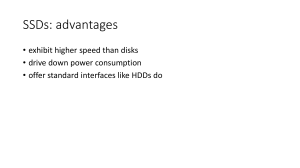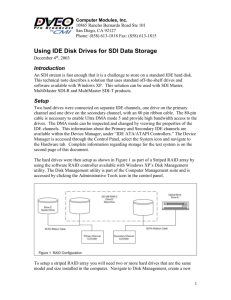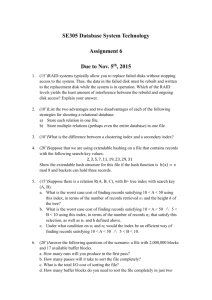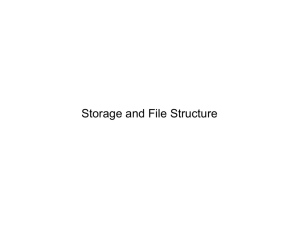A CASE FOR REDUNDANT ARRAYS OF INEXPENSIVE DISKS
advertisement
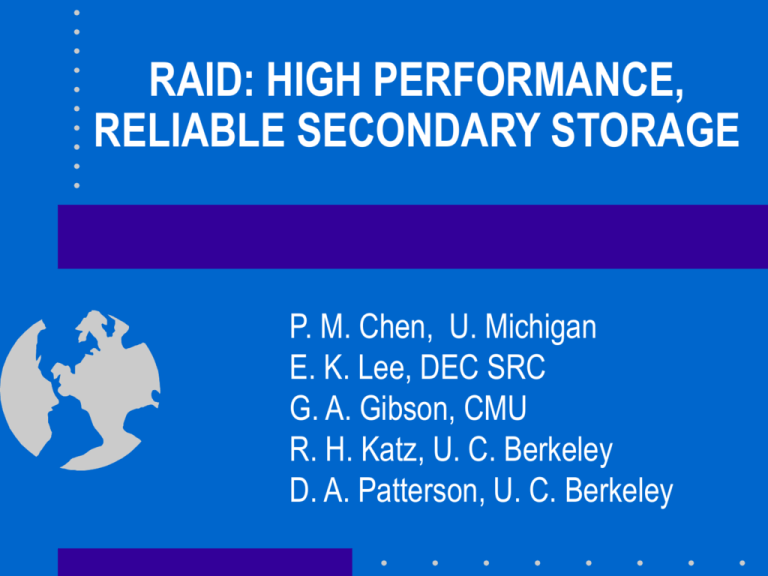
RAID: HIGH PERFORMANCE, RELIABLE SECONDARY STORAGE P. M. Chen, U. Michigan E. K. Lee, DEC SRC G. A. Gibson, CMU R. H. Katz, U. C. Berkeley D. A. Patterson, U. C. Berkeley Highlights • The seven RAID organizations • Why RAID-1, RAID-3 and RAID-5 are the most interesting • The small write problem occurring with RAID-5 – Possible solutions • Review of actual implementations Original Motivation • Replacing large and expensive mainframe hard drives (IBM 3310) by several cheaper Winchester disk drives • Will work but introduce a data reliability problem: – Assume MTTF of a disk drive is 30,000 hours – MTTDL for a set of n drives is 30,000/n • n = 10 means MTTDL of 3,000 hours Today’s Motivation • “Cheap” SCSI hard drives are now big enough for most applications • We use RAID today for – Increasing disk throughput by allowing parallel access – Eliminating the need to make disk backups • Disk drives are too big to be backed up in an efficient fashion RAID 0 • Spread data over multiple disk drives • Advantage – Simple to implement – Fast • Disadvantage – Very unreliable • RAID 0 with n disks has MMTF equal to 1/n of MTTF of a single disk RAID 1 • Mirroring – Two copies of each disk block on two separate drives • Advantages – Simple to implement and fault-tolerant • Disadvantage – Requires twice the disk capacity of normal file systems RAID 2 • Instead of duplicating the data blocks we use an error correction code • Very bad idea because disk drives either work correctly or do not work at all – Only possible errors are omission errors – We need an omission correction code • A parity bit is enough to correct a single omission RAID 2 RAID 2 Data disks RAID 3 Error correction RAID 3 • Requires N+1 disk drives – N drives contain data • 1/N of each data block on each drive • Block b[k] now partitioned into N fragments b[k,1], b[k,2], ... b[k,N] – Parity drive contains exclusive or of these N fragments p[k] = b[k,1] b[k,2] ... b[k,N] RAID 2 RAID 3 Data disks Error correction RAID 3 Data disks Parity disk A stripe consists of a single block RAID 4 • Requires N+1 disk drives – N drives contain data (individual blocks) – parity drive contains exclusive or of the N blocks in stripe p[k] = b[k] b[k+1] ... b[k+N-1] RAID 4 RAID 4 Data disks Parity disk RAID 5 multiple A stripe now contains 25%blocks Parity 75% Data RAID 5 • Single parity drive of RAID-4 is involved in every write – Will limit parallelism • RAID-5 distribute the parity blocks among the N+1 drives RAID 3 RAID 5 Data disks RAID 5 Parity disk 25% Parity 75% Data The small write problem • Specific to RAID 5 • Happens when we want to update a single block – Block belongs to a stripe – How can we compute the new value of the parity block b[k] b[k+1] b[k+2] ... p[k] First solution • Read values of N-1 other blocks in stripe • Recompute p[k] = b[k] b[k+1] ... b[k+N-1] • Solution requires – N-1 reads – 2 writes (new block and parity block) Second solution • Assume we want to update block b[m] • Read old values of b[m] and parity block p[k] • Compute p[k] = new b[m] old b[m] old p[k] • Solution requires – 2 reads (old values of block and parity block) – 2 writes (new block and parity block) RAID 6 • Each stripe has two redundant blocks: – P + Q redundancy • Advantage – Much higher reliability • Disadvantage: – Costlier updates PERFORMANCE COMPARISON • Focus on system throughput • Measure it against system cost expressed in number of disk drives Throughputs per dollar Small read RAID 0 1 Small write 1 Large read 1 Large write 1 1 ½ RAID 1 1 ½ RAID 3 1/G 1/G RAID 5 1 max(1/G, 1/4) 1 (G-1)/G RAID 6 1 max(1/G, 1/6) 1 (G-2)/G (G-1)/G (G-1)/G Discussion • Performance per dollar of RAID 3 is always less or equal to that of a RAID 5 system • For small writes, – RAID 3, 5 and 6 are equally cost -effective at small group sizes – RAID 5 and 6 are better for large group sizes RELIABILITY • Theoretical reliability is very high – Especially for RAID 6 • In practice, – System crashes can cause parity inconsistencies – Uncorrectable bit errors can happen during repair times (one in 1014 bits) – Correlated disk failures happen! Impact of parity inconsistencies • Happen when system crashes during an update – New data were written but parity block was not updated • Has little impact on RAID 3 (bad block) • Significant impact on RAID 5 • Bigger impact on RAID 6 – Same as simultaneous failures of both P& Q blocks Discussion • System crashes and unrecoverable bit errors have biggest effect on MTTDL • P + Q redundant disks protect against correlated disk failures and unrecoverable bit errors – Still vulnerable to system crashes – Should use NVRAM for write buffers IMPLEMENTATION CONSIDERATIONS • Must prevent users from reading corrupted data from a failed disk – Mark blocks located on the failed disk invalid – Mark reconstructed blocks valid • To avoid regenerating all parity blocks after a crash – Must keep track of parity consistency and store it in stable storage Discussion • Maintaining consistent/inconsistent state information for all parity blocks is a problem for software RAID systems – Rarely have NVRAM • If updates are local, keep track in stable storage of a small number of parity blocks that could be inconsistent • Otherwise use group commits SMALL WRITES REVISITED (I) • Asynchronous writes can help if future updates overwrites previous ones • Caching recently read blocks can help if old data necessary to compute new parity are in cache • Caching recently written parity can also help – Parity is computer over many logically consecutive blocks SMALL WRITES REVISITED (II) • Floating Parity – Make parity update cheaper, by putting parity in a rotationally-nearby unallocated block – Requires directories for locations of nearby unallocated blocks – Should be implemented at controller level SMALL WRITES REVISITED (III) • Parity Logging : – Defers cost of parity update by logging XOR of old data and new data – Replay log file later to update parity – Reduces update cost to two blocking writes (if we have in the old data block in RAM) – It works because nearly all storage systems have idle times. Declustered Parity (I) • Addresses issue of high read cost when recovering from a failure a failure • Looking at example: – A failure of disk 2 generates additional read requests to disks 0, 1 and 3 every time a read request is made for a block that was stored on disk 2 Declustered Parity (II) Declustered Parity (III) • With declustered parity: – Same disk belongs to different groups • Looking at example: – Disk 2 is in groups (0,1, 2, 3), (4, 5, 2 , 3) and so on – Additional read requests caused by a failure of disk 2 are now spread among all remaining disks Declustered Parity (IV) • Extra workload caused by the failure of a disk is now shared by all remaining disks • Sole Disadvantage: – A failure of any two disks will now result in data loss – In a standard set of RAID array, the two failed disks had to be in the same array Exploiting On-Line Spare Disks • Distributed Sparing: – No dedicated spare disk – Each disk has 1/(N+1) of its capacity reserved • Parity Sparing: – Also spreads the spare space but uses it to sore additional party blocks • Can split groups into half groups • More … Distributed Sparing S0, S1 and S2 represent spare blocks CASE STUDIES • TicketTAIP • AutoRAID – See presentation TickerTAIP (I) • Traditional RAID architectures have – A central RAID controller interfacing to the host and processing all I/O requests – Disk drives organized in strings – One disk controller per disk string (mostly SCSI) TickerTAIP (II) • Capabilities of RAID controller are crucial to the performance of RAID – Can become memory-bound – Presents a single point of failure – Can become a bottleneck • Having a spare controller is an expensive proposition TickerTAIP (III) • Uses a cooperating set of array controller nodes • Major benefits are: – Fault-tolerance – Scalability – Smooth incremental growth – Flexibility: can mix and match components TickerTAIP (IV) Host interconnects Controller nodes TickerTAIP ( V) A TickerTAIP array consists of: • Worker nodes connected with one or more local disks through a bus • Originator nodes interfacing with host computer clients • A high-performance small area network: – Mesh based switching network (Datamesh) – PCI backplanes for small networks TickerTAIP ( VI) • Can combine or separate worker and originator nodes • Parity calculations are done in decentralized fashion: – Bottleneck is memory bandwidth not CPU speed – Cheaper than having faster paths to a dedicated parity engine CONCLUSION • RAID original purpose was to take advantage of Winchester drives that were smaller and cheaper than conventional disk drives – Replace a single drive by an array of smaller drives • Nobody does that anymore! • Main purpose of RAID is to build fault-tolerant file systems that do not need backups


